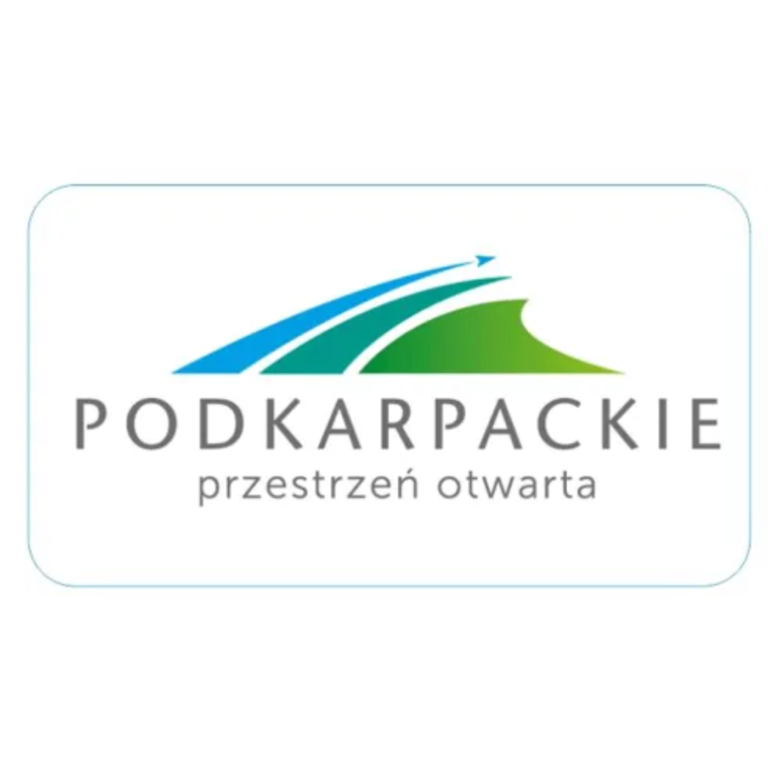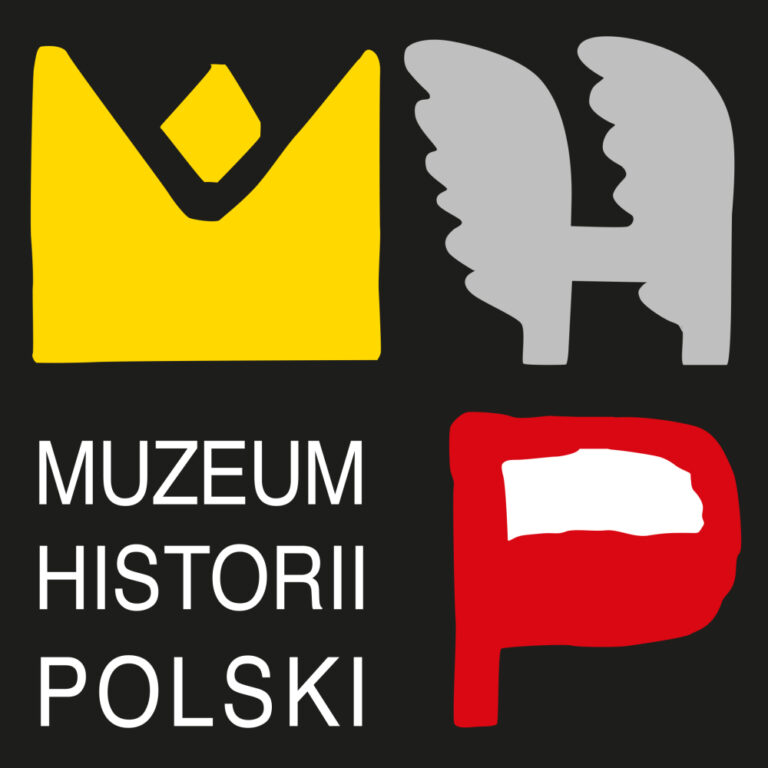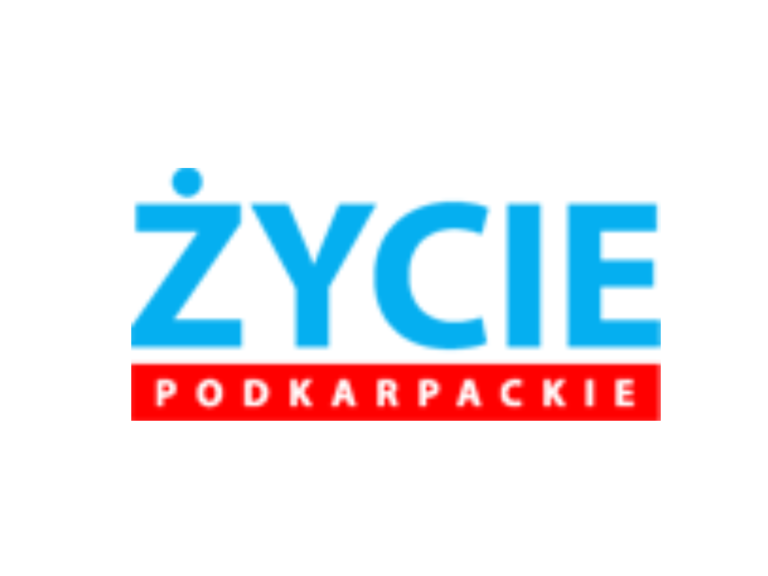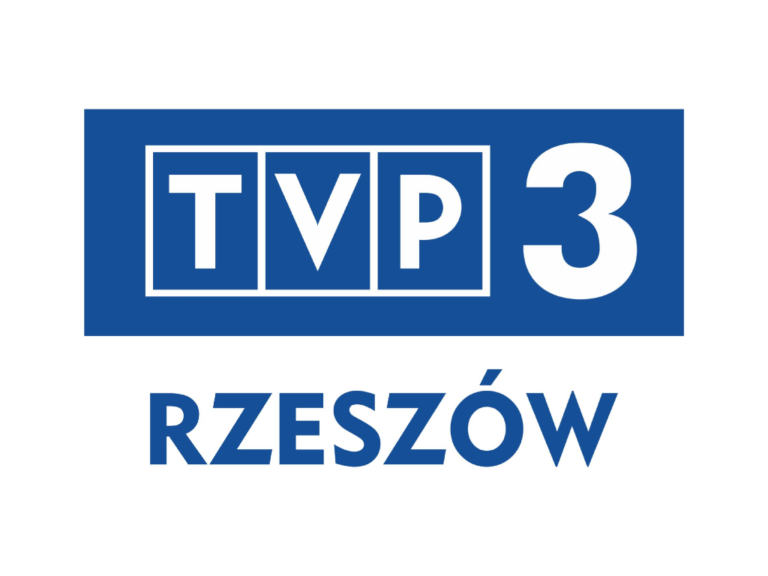About the environment of the Cultural Attic in Przemyśl
The term "cultural attic" holds two or even three meanings. One is a meeting place - an attic in a house on Węgierska Street in Przemyśl, the second - a social group, a kind of discussion club made up of people who were looking for something more than the official circulation of culture - freedom, freedom of speech, truth, higher culture. The Cultural Attic, understood in this way, was active in 1985-1989. The third meaning is the publication "Cultural Attic", which began to come out in the fall of 1989, had a circulation planned for 100 copies and was a home publication. Six issues were published.
I did not participate in the meetings and activities of the Christian Culture Clubs, which gave rise to the independent movement. In 1983, my husband, Waldemar Niezgoda, died, somehow as a result of martial law, and, plunged into mourning, I was in a different world. I remember that, among other things, a performance by Krzysztof Kolberger or a meeting with Tomasz Jastrun were organized there, but not for me.
I was invited to work with a group of people who formed a magazine later called "Cultural Strych" by Krzysztof Kaniewski, a journalist, publisher, tourist organizer, an important figure in our environment. I was probably a good acquisition - I had been running Desa's antique showroom in Przemyśl since 1973, and a contemporary art gallery (Desa Gallery, 5 Fredry Street) since 1976, and I knew the art community well, and could help organize exhibitions, both substantively and practically, such as by lending picture frames. We met in the Kaniewski's apartment, in the attic of a building at 2 Cathedral Square, now home to the Przemyśl Archdiocesan Museum, but then, in 1985, the building belonged to the Przemyśl District Museum, now the National Museum, and Krzysztof's wife Basia, was an art conservator there, and they used a staff apartment. Present at the meeting were the host, Marek Kuchcinski, myself and Marek Zazula - a musician, graduate of the Kraków Academy of Music, cellist, conductor, founder of the Capella Premislennsis ensemble, one of the most prominent people of the independent movement. After these deliberations, we already began to work concretely. We started a series of poetry meetings. The first one took place in my apartment - with Baśka Tondos, while the second - in the apartment of Marek Kuchciński's parents, on Matejki Street - with Jozef Kurylak, whom we didn't know at the time that he was an SB agent. The meeting with Baśka was somehow not recorded in the "Attic" calendar, but the one with Jozef is - August 1985. Such were the first events of the cultural attic in Przemyśl, that is, in fact, in this attic, according to my calculations, we met for the third time, because in reality it is always a bit different than in collective memory - the Hundred Years' War lasted one hundred and sixteen years, the October Revolution took place in November, and the cultural attic began with a block of apartments on 22 Stycznia Street and in an apartment on Matejki Street.
Going back to the first meeting - Barbara Tondos, an art historian from Rzeszow, an acquaintance of mine, for the second-circulation event, outside the censorship, was chosen deliberately. Baśka and her husband Jurek Tur ran a point in Rzeszów with underground publications, and we were all three in a group of people who supported the KOR - the Committee for the Defense of Workers. I traveled regularly to Rzeszow to pick up the tissue paper - books, newspapers - all sorts of independent prints, gadgets like badges, banknotes with Jaruzelski, etc., and distributed this in Przemysl. Some of these publications were free, but most of them were quite expensive, as funds were needed for the activity - for ink, paper, transportation, etc. Distribution was free, because we did not earn money on this activity - for what price I bought the publication, I passed it on. Barbara Tondos and Jerzy Tur are legendary figures in Podkarpacie, with great achievements in the field of art history. To honor and preserve the memory of them, a commemorative book "Nothing over the original" was published, scientific conferences were held on their subject, they have a great contribution to independence.
I had already entered this attic activity in Przemysl with my history in the underground movement, although Krzys Kaniewski, inviting me, was unlikely to know this, we were, after all, operating in the underground.
Who was at that first meeting? Today I don't remember, certainly Marek Kuchcinski, Marek Zazula and Jozef Kurylak, who, by the way, didn't like Baśka Tondos' poems and attacked them. I also don't remember who attended the meeting with his poetry - maybe Jan Musial, a polonist and journalist, the future governor and chancellor of the university, and in our movement the future editor of the "Cultural Attic" publishing house. Maybe Janusz Czarski, a polonist and teacher, then a long-time, two-time director of the Cultural Center in Przemyśl, who already in free Poland brought Krzysztof Penderecki, Leszek Mądzik and other great artists to Przemyśl, and organized many important cultural events. That's what the phenomenon of the Attic Group was, that we were looking for high culture and no initiatives were too difficult for us.
What does "cultural attic" mean, where did the name come from? Marek Kuchcinski, who is certainly the most important person in the movement, had a garden house on Wegierska Street with a beautiful orchard and a foil under which tomatoes were grown. He hauled them for sale to the stock exchange in Silesia. The first floor of this cottage was quite ordinary - a kitchen with an old sideboard, two rooms, but the upstairs, the attic, was adapted into a living room - a living room, basically a single space with lots of books, with paintings and armchairs. When Marek prepared this attic for meetings, it was already hard to look for something better - everything was there: space, seats, a beautiful atmosphere and a kind host who embraced it all. Marek also had a car, a Toyota, and this car, in addition to delivering tomatoes, was also used to bring guests, especially from Warsaw, but sometimes also from Lublin or other places. Incidentally, it can be added here that the SB gave Marek the code name "Toyota" - highly original. It was Marek who, through his contacts, invited to the attic most of those illustrious people who appeared among us, he also coordinated the work of myself, Zazula, Musiał, Bonark, Kaniewski or Jarosz. That is, he was the host, organizer of these meetings, also co-organizer of exhibitions and co-editor of the publication. Meetings strictly in the attic began in 1985.
I knew this attic on Węgierska Street before, I used to go there for social meetings of the artistic community of our city. Marek's first wife, Iwona Miśkiewicz, is a painter, very interesting, she paints sensitive, sublime paintings with depictions of trees, birds, nature. During her stay in Węgierska Street, there was a small room in the middle of the attic set aside for a painting studio, and we used to frequent this attic.
It should also be added that meeting in homes was quite common in those days. Now it is not practiced in principle. Nowadays, after a vernissage or other occasion, we go to a cafe, bar or pub, but back then the pubs were terrible, empty, with poor and unhelpful service, and our generation no longer went there, unlike our parents, who still cultivated the pre-war tradition of dancing. Not to speak of the primary reason for meeting in homes - seeking a breather from the security services. So at the slightest opportunity, someone would take guests to his home. In the case of the loft, besides Węgierska, it was just my house, that is, an apartment in a block of apartments on 22 Stycznia Street. We ended up there, for example, after the "Man - God - World" festivals. Several meetings were also held at the home of Marysia Strońska, the daughter of a painter, a cat breeder, her beautiful house on Matejki Street, full of paintings, was also open to us.
Intellectually and through their contacts, the powerhouse, foothold and mainstay of the loft was Marta Sienicka, a translator and English speaker, together with her partner, also an English speaker, Stefan Makowiecki. They were from Warsaw and it was they who sent many great people to our meetings, they would come with this guest and Marta would translate from English during the lecture. Both Marta and Stefan, as well as Stefan's sister Elżbieta Makowiecka, had their own speeches in the attic. It was thanks to Marta that Helen Ganly, a great artist from Oxford, came to Przemysl and has kept in touch with us to this day, although she now finds it difficult to travel. She came to us in a group of other Oxford artists - they were Alan Franklin, Cally Le Poer Trench, Roger Perkins. Helen later joined the group of Slonim artists, and continues to collaborate with Jadwiga Sawicka in artistic activities.
Jadwiga Sawicka is among Przemysl artists a figure of the greatest career and fame. A visual artist - painter, author of installations, curator of exhibitions, professor at the UR Faculty of Art, she has her works in the collections of the National Museum in Cracow or Zachęta, among others, and has her chapter in the album "Female Artists" alongside Boznanska or Stryjeńska. She has exhibited in New York, Vienna, etc. She was at the Attic from the beginning, and artistically developed the second issue of the "Cultural Attic" publication. From the beginning, the graphic level of this periodical was outstanding, the first issue was designed by Miroslaw Kocol, a graphic designer, academic teacher at the Nicolaus Copernicus University in Torun, draughtsman, art therapist. Together with his wife, artist Beata Bober-Kocol, they left Przemyśl for Toruń. The third issue was illustrated by Jadwiga's then-husband, Stanislaw Koba, a critical artist who graduated from the Academy of Fine Arts in Cracow and now lives there. Further issues were graphically designed by: Mariusz Kościuk, Marek Mikrut and Andrzej Cieszyński.
Even from the time of the Club of Catholic Intelligentsia there was Jerzy Bonarek in this group, he was in charge of books and stayed with books, today he is the owner of Libera bookstore and cafe, a favorite place of przemyślanie. Jurek's role could not be overestimated in logistical activities. In the field of books, he was supported in this work by his future wife Beata. Lucyna, later Czarska, Janusz's wife, a museum conservator, was also an important participant in the meetings. Brigid Pisz-Busz, also an important participant in most of the meetings, is a conservator from the same department at the museum. Her future husband Mirek Busz, a doctor, also attended.
Meetings were held on the basis of meetings, for example, in a library or club, where you come in, eat and drink nothing, listen to a lecture and then leave. Of course, some small group stayed a little longer, cooked, ate and drank.
I may write a separate substantive text about our exhibition activities someday, with stories about artists and characteristics of exhibitions, but here, in talking about the environment of the attic, it is worth mentioning a certain exhibition - in the basement of the Franciscan monastery, two friends, participants of attic meetings, przemyślans - Jerzy Cepiński and Mariusz Kościuk presented their works. Both graduates of the Academy of Fine Arts in Cracow, they showed abstract painting, each quite different - Jurek was then an unbridled, expressive Tasist, while Mariusz was looking for sophisticated compositional and color solutions. The Franciscans gave us the rooms of the church basement free of charge and cordially, we entered from the level of Franciszkańska Street. The curia and the monastery were perhaps spoken to by Marek Zazula, he was the one who was well versed in these spheres, and he often conducted bilateral diplomacy. But there were others, too. In addition, we had the support of Bishop Antoni Tokarczuk and the pastor of my parish, Father Stanislaw Zarych. Both priests left their beautiful imprint on the history of Przemyśl.
The Franciscan underground remained our main exhibition room until 1989. It should be noted here that the hosts, the Franciscan fathers, never interfered with the content of the exhibited works. I remember a visually controversial but very poignant painting by Janusz Szpyt. The work was quite drastic, but the exhibition was not banned.
It's hard to believe today, but we organized about 50 exhibitions there. To mention here would be the exhibitions of Tadeusz Boruta, Zygmunt Czyz or Jacek Fedorowicz, with whom I have worked for some time. The most important for us was the "Man - God - World" festival, developing from edition to edition. It started as an exhibition of artists from Przemysl, then the archdiocese, and the next, third one was already international - Germany, England, Scotland, USA, South Africa and others. We used my address lists and artist rosters that I had collected while running the gallery. In addition to three major festivals, we also organized two open-air art events in Krasiczyn. We housed the participating artists at the rectory in Krasiczyn with the unforgettable and legendary priest Stanislaw Bartminski. His warm support helped us a lot in the often difficult troubles. I would like to take this opportunity to mention another important figure of the attic, Father Staszek's brother, Jan Bartminski, a future governor and long-time councilor of the city of Przemysl.
From the circle of visual artists, painters Alina Czarnecka-Mikrut and Marek Mikrut also frequented the attic. Marek is now the deputy director of the National Museum of the Przemysl Region, he also does graphic design for all museum prints, and continues to paint. He creates landscapes and vedutas, very personal, in stark, not always real colors. Alina paints, photographs and makes films, and in her paintings seeks to convey emotions through color.
The director of the National Museum of the Przemysl Region is now Jan Jarosz, in his loft days we called him "Szczawik" - for he was very young, only after studying history. He was happy to help, bringing visitors from Warsaw and other cities, Mark's toyota, probably the only car in our company at the time, was used for this purpose.
Of the people I invited to work with the Przemyśl loft, Magda Hniedziewicz and Maciej Gutowski should be mentioned. They were well-known art critics from Warsaw. At that time there was such a form as art reviews in periodicals, now there are rather curators and critics representing individual creative groups. I met the Gutowski couple at the "Way and Truth" festival of independent culture in Wroclaw, and because they delighted me, I asked them to be part of the jury of the "Man - God - World" festivals. They were also, in some form, participants in open-air events in Krasiczyn, and frequented attic meetings. It is worth mentioning here some other jurors of festivals, such as Janusz Eysymont, Henryk Waniek, both from Warsaw - these names can make us proud, also Kazimierz Wiśniak, an outstanding stage designer and painter from Cracow, my friend, with whom we published a book together. I haven't named all the participants of the attic, Ela, Beata Bonarkowa's sister, a dentist, came to the meetings, Boguś and Urszula Zaleszczykowie, Wojtek and Janina Kalinowski, Lucyna Łukasik currently Podhalicz, Janusz Obłąk, Mieczysław Dudek, Basia and Wojtek Mikuła, Urszula and Mariusz Olbromski, Jadwiga and Krzysztof Repel came. Wojtek Mikuła will later become president of the company Ziemia Przemyska, which publishes the weekly newspaper "Życie Podkarpackie," while Mariusz Olbromski will first be director of the Department of Culture at the Provincial Office, then director of the Przemyska Land Museum. Urszula Olbromska is an art historian, Basia Mikuła a bookseller and Krzysztof Reppel an architect. Waldemar Wiglusz and Jacek Borzęcki also visited.
Our meetings were watched by the services, and although we didn't talk about it, many anecdotes of their actions against us have survived. I can only tell about myself: I was harassed in a way that was exceptionally oppressive to me. Unknown perpetrators often broke the display glass in the desa showroom. These problems ceased somehow after 1989. After such an incident, I had to spend the night in the store for the safety of antiques, and each time I got cold. On one occasion, when I was in the attic and the glass was broken again, the policeman reporting the incident called our house, vulgarly taunted and intimidated my 10 - I think - year-old son, who stayed at home, demanding that he tell him where I was. Of other harassment: on one occasion, an officer questioning me and urging me to cooperate, asked: "You are so smart, and after all, you have a small child, aren't you afraid?". "I am very afraid for him," I replied, "every night. My son Jedrzej can be seen in many attic photographs from that time, which means he too can be called a participant in these events.
In March 1989, I went to Belgium, to Antwerp, for a few days, and when I returned, I saw a large sign on the fence of the parish of the Salesian Fathers: "Vote for the opposition." This came as a great shock to me, for the word "opposition" did not exist in the social dictionary under the Communists. When it came to working on the elections, we in Przemyśl had ready social connections, we knew each other, we trusted each other, we were prepared, and we could get to work right away. I think this was one of the reasons why the June 4 movement won - well-organized groups all over the country, able to identify both those who ran and those who carried out the elections. And the Przemyśl environment was exceptionally strong.
My signature was on Jan Musial's recommendation for the Senate, and we founded the Civic Committee. I remember the pre-election march through the streets of the city, when on May 3 Street we chanted "Ja - nek Mu - siał to Se - nat, Ony - szkie - wicz to Sejm!". It was an unimaginable joy to loudly, openly take a side other than the authorities. Crowds came to election meetings, people stood in the rain, there were not enough seats in the meeting rooms.
In the Civic Committee, I led the Culture Committee, we wrote a program for culture, for education, many of us entered the election committees on behalf of the Committee. I worked on June 4 in the election commission at the school on Lukasinski Street and counting the results was wonderful. Later, still at the Committee's premises at 1 Legion Square, together with Wojtek Mikuła, we counted some poles in a controlled manner. Euphoria! We had won! The fourth of June 1989 completely changed the situation in the country, and therefore our lives. One of the most important days in Polish history.
Grażyna Niezgoda
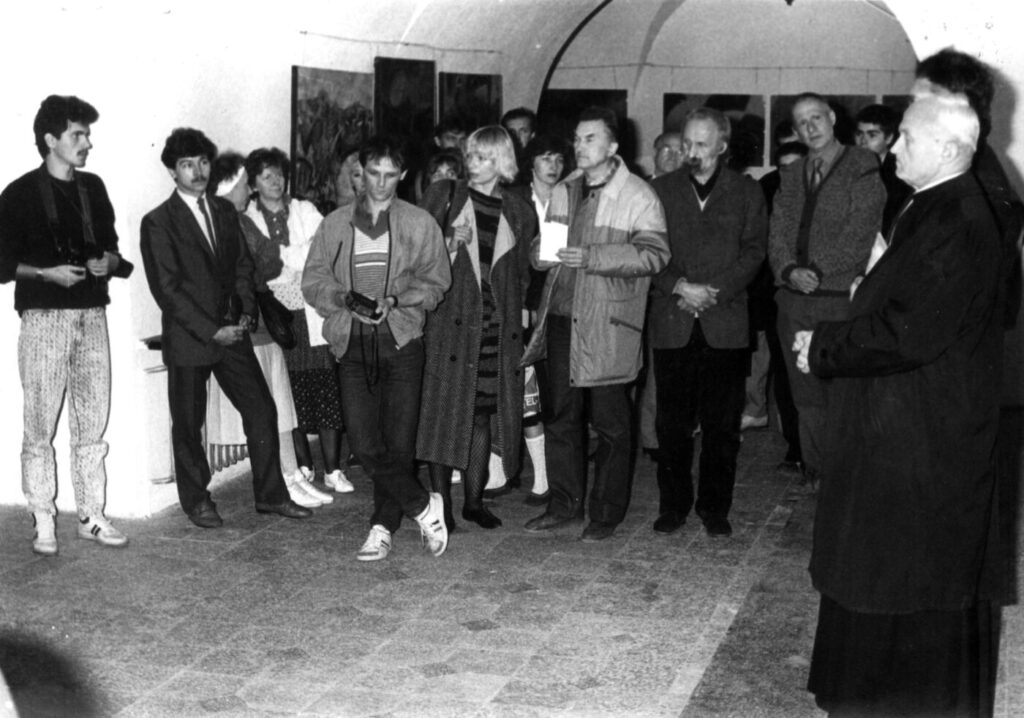
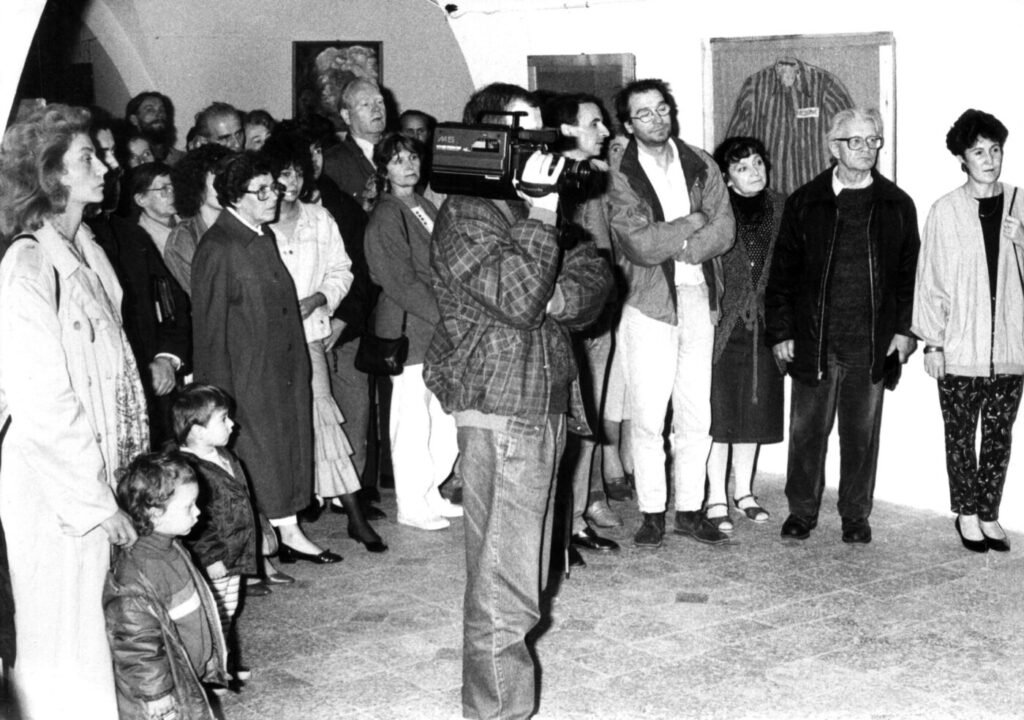
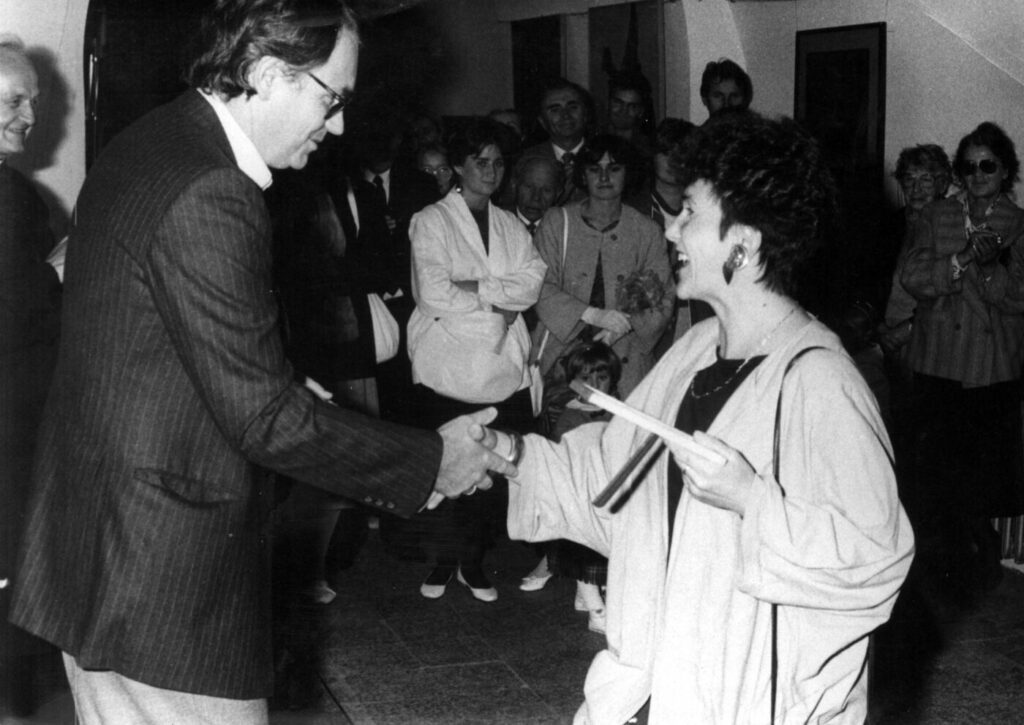
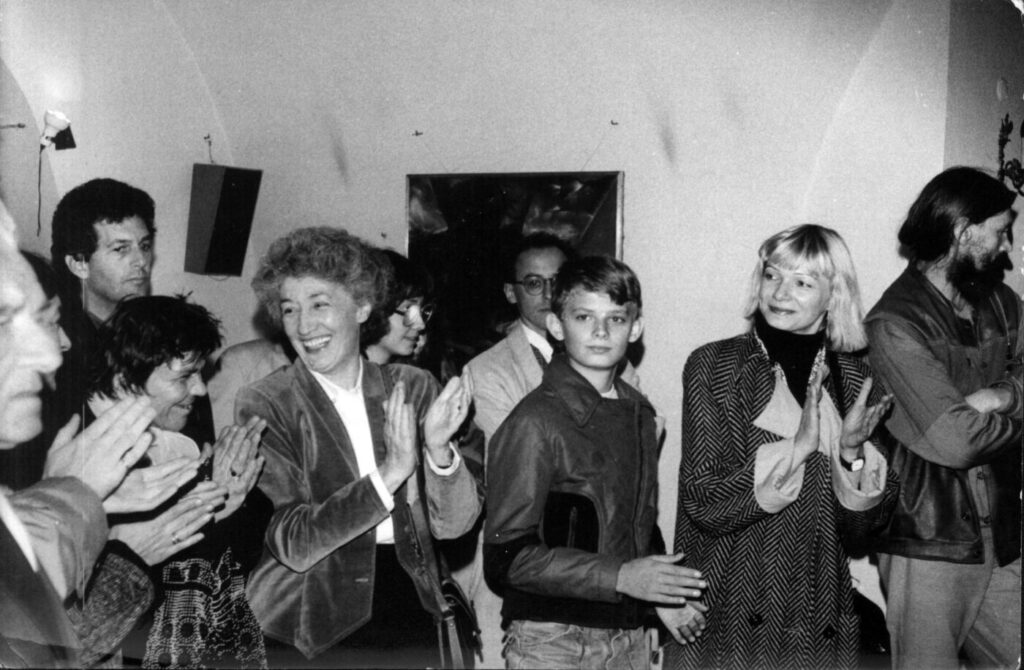

siedzą od lewej: Stanisław Koba, Grażyna Niezgoda, Marek Kuchciński, Lucyna Hałasik (Podhalicz), Marek Matraszek, Jan Jarosz. Jamnik Felek należy do gospodyni. Zdjęcie zrobiono latem.
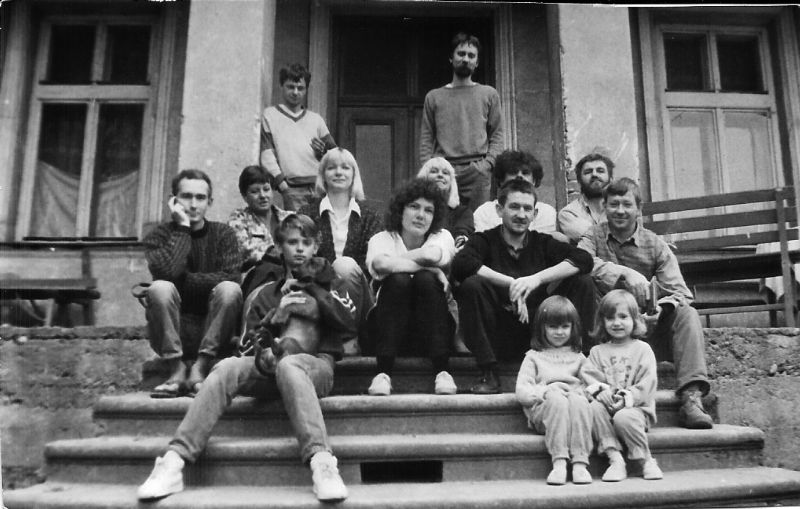
standing from left Mariusz Kościuk, Jerzy Cepiński next row from left: Roger Perkins, Magdalena Hniedziewicz, Grażyna Niezgoda, Helen Ganly, Janusz Młynarski, ? next row: Cally Trench, Stanislaw Koba, Alan Franklin. Lowest: Jedrzej Niezgoda with his dachshund Felk, the daughters of Mariusz Kościuk and Jerzy Cepinski.


